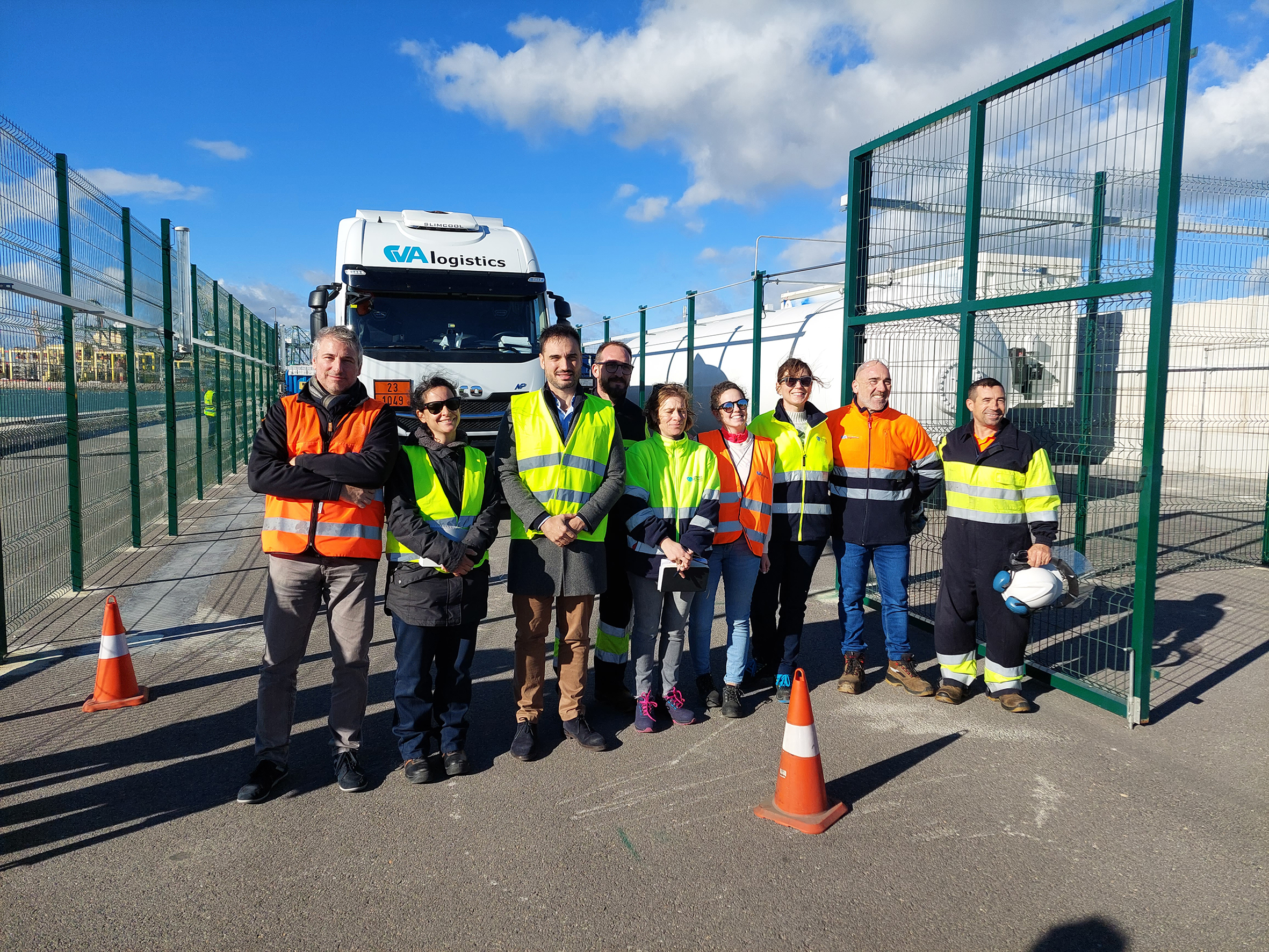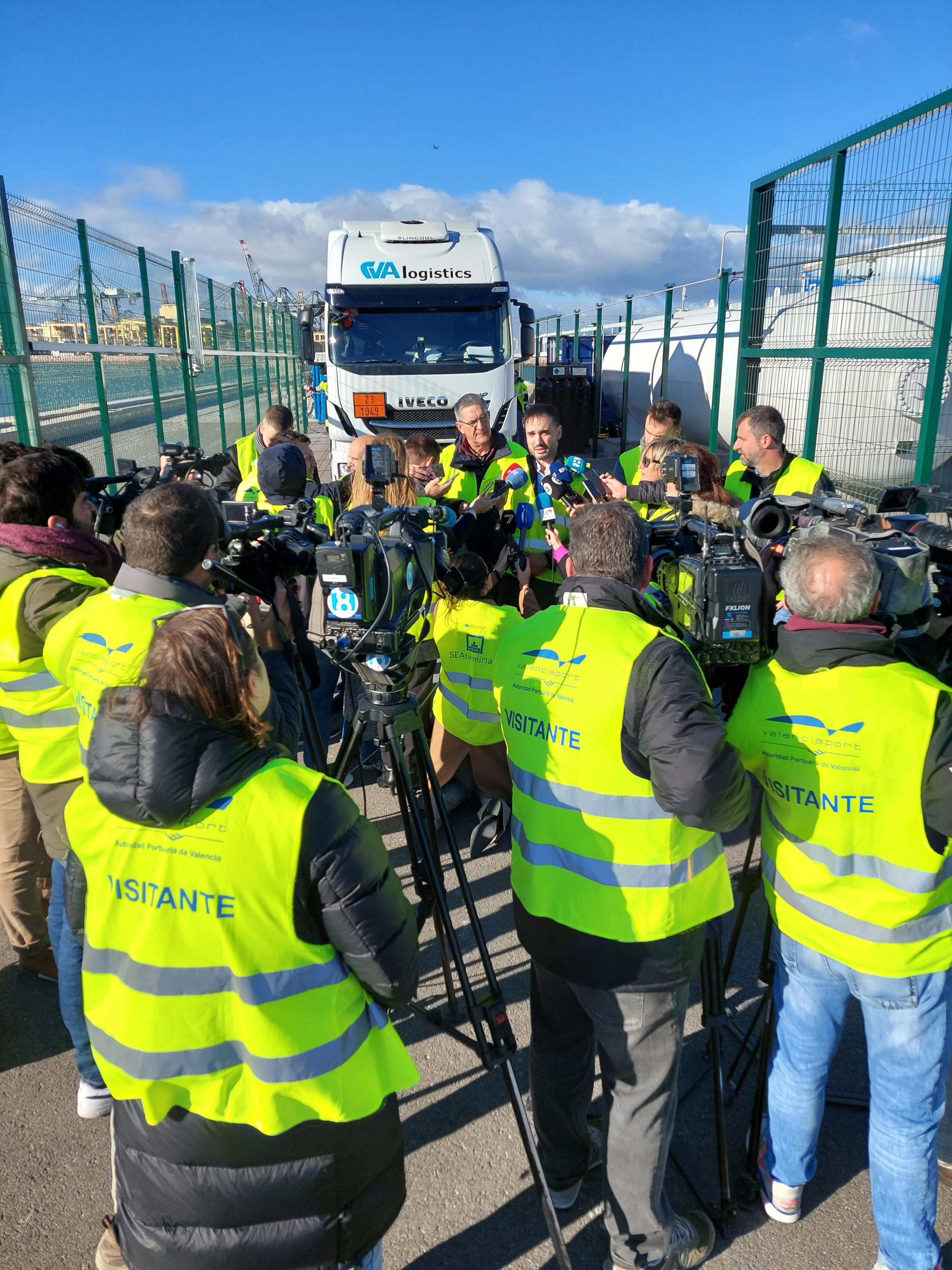- The storage tank was filled with H2 today and the mobile hydrogen plant will be filled next week
- During the first quarter of the year, the other two prototypes of this project will arrive at the Valencia site: a ‘Reachstacker’ or container stacker and a 4×4 tractor unit
- The Port of Valencia is a pioneer in Europe in the use of hydrogen technology in terminal operations
- Raúl Cascajo, Head of Environmental Policies at Valenciaport: “With this milestone of the first hydrogen refuelling of the refuelling station, we are highlighting the value and real facts of Valenciaport’s commitment to decarbonisation”
- Cristina Ballester of the National Hydrogen Centre: “We are proud that this technology is being developed and researched in Spain”.
- Aurelio Lázaro, Fundación Valenciaport Project Manager: “The next step is to test the use of H2 in the Reachstacker machines and the tractor unit, two pioneering vehicles that will allow us to test the real use of this fuel in port operations”.
València, 17 January 2023.- Valencia is the Port of Hydrogen. The Valencian precinct has received the first load of hydrogen (H2) to supply the refuelling station located on the Xità quay. This historic milestone makes it the first port in Europe to have a hydrogen installation in real operating conditions. It is the only installation capable of supplying the needs of the terminals through the mobile hydrogen plant and the fixed tank that stores this fuel. A turning point for the port community and the European ports to start testing one of the fuels of the future.
This hydrogen supply station (HRS) includes a fixed part that is dedicated to the reception, storage and compression of hydrogen up to the delivery pressure, on which the test was carried out today, and a mobile part that stores the compressed hydrogen and has a dispenser for refuelling port machinery.
This morning at 10.30 a.m. the first tubetrailer of green hydrogen cylinders arrived at the hydrogen plant and was loaded into the storage tank at the Port of Valencia. Different tests were carried out for about an hour to prepare the entire operation for filling the fixed tank located on the Xità quay with H2.
The test was attended by technicians from the Port Authority of Valencia (APV), Fundación Valenciaport, the National Hydrogen Centre – in charge of the design and construction of the station – and Carburos Metálicos – the company supplying the hydrogen. Next week, the mobile station will be loaded and will be responsible for travelling to the MSC and Grimaldi terminals to supply hydrogen to the two prototypes of port machinery, which will arrive in the near future, where this clean fuel will be tested.
Specifically, it will be tested on a ‘Reachstacker’ vehicle or container stacker and a 4×4 tractor unit. In the coming weeks, a team of dockers and technicians from Valenciaport will travel to Holland to test the Reachstacker, which is being designed by Hyster Europe. The ro-ro tractor is being adapted by Atena Distretto. Both will run on fuel cells and electric motors, which will be powered by H2, and will be zero-emission.
The head of Environmental Policies of the APV, Raúl Cascajo, stressed that “this project is strategic for the reduction of emissions and is in addition to other initiatives such as the installation of photovoltaic plants or wind turbines to meet our commitment to be a zero emissions port by 2030. This H2Ports initiative is the first to be carried out in a European port to test mobility and its use in machinery. With this milestone of the first hydrogen refuelling of the supply station, we are highlighting the value of Valenciaport’s commitment to decarbonisation and making it a reality”.
“Today is a very important day for the Port of Valencia because we are starting to work with renewable hydrogen by filling the hydrogen plant with this fuel. This project is part of Valenciaport’s decarbonisation plans and represents a further step towards the 2030 goal of zero emissions and becoming an emission-neutral port”, explained Aurelio Lázaro, head of the H2Ports project at the Fundación Valenciaport, who pointed out that “the next step is to test the use of H2 in the Reachstacker machines and the tractor unit, two pioneering vehicles that will allow us to check the real use of this fuel in port operations”.
For her part, Cristina Ballester of the National Hydrogen Centre stressed the importance of “introducing hydrogen technologies in a port as strategic as Valencia through a portable station to supply this clean fuel to the two prototypes of machinery at the MSC and Grimaldi terminals. It is a very ambitious research project with a view to the ports being able to generate hydrogen and be able to manage themselves so that all the port machinery operates with zero emissions”. For Cristina Ballester, “that such powerful projects develop engineering and research in Spain is a great value and very important for positioning our country”.
Project supported by the European Union
This initiative is part of H2Ports -Implementing Fuel Cells and Hydrogen Technologies in Ports-. It is an initiative coordinated by the Fundación Valenciaport in collaboration with the Port Authority of Valencia (APV) and is funded by the European Union’s Clean Hydrogen JU programme. Its main objective is to test and validate hydrogen technologies on port machinery that will provide applicable and real solutions without affecting the performance and safety of port operations and producing zero local emissions. The Port of Valencia started working with hydrogen in 2019, before this project was launched.
The H2Ports project will entail a total investment of more than 4 million euros and involves, in addition to the Fundación Valenciaport and the APV, the research centres Centro Nacional del Hidrógeno and Atena Distretto Alta Tecnologia Energia Ambiente and the private companies MSC Terminal Valencia, Grimaldi Group, Hyster-Yale, Ballard Power Systems Europe, Carburos Metálicos and Enagás.
Valenciaport is committed to the fight against climate change and decarbonisation through different actions with the aim of becoming an emissions neutral precinct by 2030. Hydrogen is one of the lines of work being carried out by the Valencia port, which has been recognised by the Spanish Government as a benchmark within the framework of the ‘Hydrogen Roadmap’. In fact, the APV is participating in various international projects such as H2Ports, of which the hydrogen plant forms part, or Green Cranes, in which the adaptation of cranes to sustainable fuels is being analysed.









